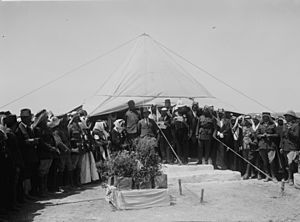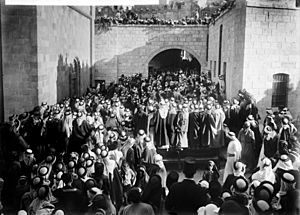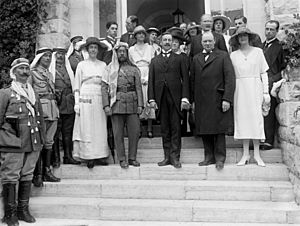Establishment of the Emirate of Transjordan facts for kids

The Emirate of Transjordan was a government set up in the area known as Transjordan on April 11, 1921. This happened after a short time when there was no clear ruler.
Abdullah, who was the second son of Sharif Hussein, arrived in Ma'an in southern Transjordan on November 21, 1920. His father, Sharif Hussein, had led the Great Arab Revolt against the Ottoman Empire in 1916. Abdullah's goal was to fight the French in Syria. The French had recently defeated the Arab Kingdom of Syria in a battle in July 1920.
At that time, Transjordan was in a state of confusion. It had many small, disorganized local governments. Abdullah stayed in Ma'an for nearly four months. He then moved to Amman on March 2, 1921. After a meeting called the Cairo Conference and another meeting between Abdullah and Winston Churchill (a British leader) in Jerusalem, the Emirate of Transjordan was officially created on April 11, 1921.
Contents
Why Transjordan Was Formed
For about 400 years, the Ottoman Empire ruled over the Levant (which includes modern-day Jordan) and the Hejaz. This rule ended during World War I because of the 1916 Arab Revolt. This revolt happened because people had been unhappy with the Ottoman rulers for a long time, and Arab people wanted their own independent nations.
The revolt was led by Sharif Hussein of Mecca and his sons, including Abdullah and Faisal. They were part of the Hashemite family, who are descendants of the Prophet Muhammad. Many local groups in Transjordan, like Bedouins, Circassians, and Christians, supported the revolt. Britain and France, who were allies in World War I, also helped the Arabs because it fit their own interests.
The revolt began in June 1916 and moved north. It reached Transjordan in July 1917. The revolt reached its peak when Faisal entered Damascus in October 1918. He set up an Arab government there, which was called the Arab Kingdom of Syria. Transjordan was part of this new kingdom.
However, this new Arab Kingdom did not last long. French troops defeated it in July 1920. This left Transjordan without a clear government for a while. The hopes of the Arabs for a big, independent state were not recognized by other countries. This was mainly because of a secret agreement made in 1916 called the Sykes–Picot Agreement. This agreement divided the Middle East into areas controlled by Britain and France. Also, the 1917 Balfour Declaration promised a homeland in Palestine for Jewish people. The Hashemites and other Arabs felt betrayed by these agreements. They believed Britain had promised them an independent Arab state in earlier letters.
Meetings About Transjordan's Future
After the Arab Kingdom of Syria fell, leaders in Transjordan and British officials discussed what should happen next.
The Salt Meeting
On August 21, 1920, Herbert Samuel, a British High Commissioner, visited Al-Salt. He told about 600 local leaders that Britain wanted Transjordan to be governed separately from Palestine. He also said that British advisors would help set up local governments. He promised that Britain would provide supplies and that trade with Palestine would continue to help the economy.
The Umm Qais Meeting
About a month later, on September 2, another meeting took place in Umm Qais. Local residents gave a list of demands to a British official. They wanted an independent Arab government in Transjordan led by an Arab prince. They also wanted a group of representatives to make laws and manage the country. They asked for an end to land sales to Jewish people in Transjordan and to stop Jewish immigration there. They also wanted Britain to fund a national army and keep free trade in the region.
Local Governments Formed
After these meetings, the British sent six officers to help set up local governments in Transjordan. These governments existed between August 1920 and March 1921. Some of them included:
- A government in Ajloun's Kura district.
- A government in Jabal Ajloun.
- A government in Karak.
- A government in Tafila.
- A government in Al-Salt.
- An administration in Irbid.
- An administration in Jerash.
Abdullah's Journey to Transjordan
Sa`id Al-Mufti, an important leader in Transjordan, sent a message to Sharif Hussein. He asked Sharif Hussein to send one of his sons to help bring order to the country. Sa'id remembered that after the French took over Syria, Transjordan was in chaos.
Abdullah's plans changed when a revolt against the British began in Iraq in May 1920. Then, his brother Faisal's Arab Kingdom of Syria was defeated by the French in July 1920. Abdullah left Medina in mid-October. His journey was long, about 800 kilometers (500 miles), and took 27 days. This was because the Hejaz railway had been badly damaged during World War I.
Abdullah said he was traveling to win back the kingdom his brother Faisal had lost.
Abdullah arrived in Ma'an in southern Transjordan on November 21, 1920. He invited leaders from Syria and important people from Transjordan to meet him in Ma'an. He wanted to discuss the "firm intentions of the people." Two weeks later, he announced that his only goal was to "expel the invaders." The British tried to stop some Transjordanian leaders from joining Abdullah.
In January 1921, Abdullah's forces moved into Karak without any fighting from the British. Abdullah stayed in Ma'an for almost four months. He left on February 28, 1921, and arrived in Amman on March 2, 1921.
By early February 1921, the British realized that Abdullah's influence had taken over from the local governments and British advisors in Transjordan. They understood that if Abdullah moved north, most people would see him as the ruler of the country.
The Cairo Conference
The Cairo Conference was organized by Winston Churchill, who was then Britain's Colonial Secretary. It started on March 12, 1921, and ended on March 30. The conference decided that Transjordan would be added to the British mandate for Palestine. Abdullah would become the emir (ruler) under the authority of the British High Commissioner. However, the conference also decided that the parts of the Palestine mandate about creating a Jewish National Home would not apply to Transjordan.
Meeting in Jerusalem
After the Cairo Conference, Abdullah went to Jerusalem to meet with Winston Churchill on March 28, 1921.
The Emirate of Transjordan is Declared
After reaching an agreement with Winston Churchill, the Emirate of Transjordan was officially established on April 11, 1921.



